
SUPIR
SUPIR aims at developing Practical Algorithms for Photo-Realistic Image Restoration In the Wild. Our new online demo is also released at suppixel.ai.
Stars: 3987
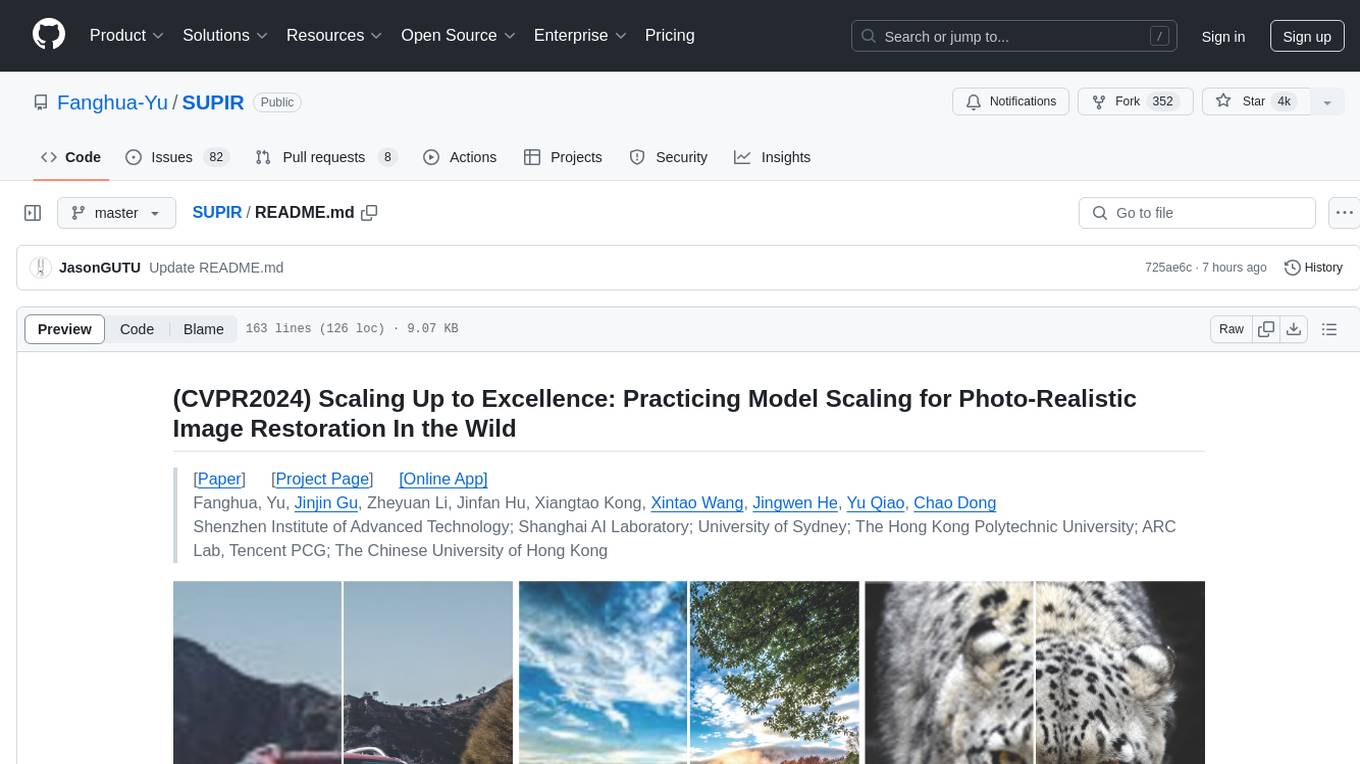
SUPIR is an AI-based image processing and upscaling tool that leverages cutting-edge technology to enhance image quality and resolution. The tool provides users with the ability to upscale images with high generalization and quality, as well as specific settings for light degradation scenarios. It offers a range of models and checkpoints for different use cases, along with detailed instructions for installation and usage. SUPIR also includes features for color fixing, linear CFG adjustments, and various prompts for image enhancement. The tool is designed for non-commercial use only and comes with a contact email for inquiries and permission requests for commercial use.
README:
(CVPR2024) Scaling Up to Excellence: Practicing Model Scaling for Photo-Realistic Image Restoration In the Wild
[Paper] [Project Page] [Online App]
Fanghua, Yu, Jinjin Gu, Zheyuan Li, Jinfan Hu, Xiangtao Kong, Xintao Wang, Jingwen He, Yu Qiao, Chao Dong
Shenzhen Institute of Advanced Technology; Shanghai AI Laboratory; University of Sydney; The Hong Kong Polytechnic University; ARC Lab, Tencent PCG; The Chinese University of Hong Kong
🚀 We're thrilled to announce the official launch of SupPixel AI! Experience the next level of image processing and upscaling with our cutting-edge AI technology based on SUPIR. Explore now for free at suppixel.ai.
-
Clone repo
git clone https://github.com/Fanghua-Yu/SUPIR.git cd SUPIR -
Install dependent packages
conda create -n SUPIR python=3.8 -y conda activate SUPIR pip install --upgrade pip pip install -r requirements.txt
-
Download Checkpoints
For users who can connect to huggingface, please setting LLAVA_CLIP_PATH, SDXL_CLIP1_PATH, SDXL_CLIP2_CKPT_PTH in CKPT_PTH.py as None. These CLIPs will be downloaded automatically.
- SDXL CLIP Encoder-1
- SDXL CLIP Encoder-2
- SDXL base 1.0_0.9vae
- LLaVA CLIP
- LLaVA v1.5 13B
- (optional) Juggernaut-XL_v9_RunDiffusionPhoto_v2
- Replacement of
SDXL base 1.0_0.9vaefor Photo Realistic
- Replacement of
- (optional) Juggernaut_RunDiffusionPhoto2_Lightning_4Steps
- Distilling model used in
SUPIR_v0_Juggernautv9_lightning.yaml
- Distilling model used in
-
SUPIR-v0Q: Baidu Netdisk, Google DriveDefault training settings with paper. High generalization and high image quality in most cases.
-
SUPIR-v0F: Baidu Netdisk, Google DriveTraining with light degradation settings. Stage1 encoder of
SUPIR-v0Fremains more details when facing light degradations.
- Edit Custom Path for Checkpoints
* [CKPT_PTH.py] --> LLAVA_CLIP_PATH, LLAVA_MODEL_PATH, SDXL_CLIP1_PATH, SDXL_CLIP2_CACHE_DIR * [options/SUPIR_v0.yaml] --> SDXL_CKPT, SUPIR_CKPT_Q, SUPIR_CKPT_F
RealPhoto60: Baidu Netdisk, Google Drive
Usage:
-- python test.py [options]
-- python gradio_demo.py [interactive options]
--img_dir Input folder.
--save_dir Output folder.
--upscale Upsampling ratio of given inputs. Default: 1
--SUPIR_sign Model selection. Default: 'Q'; Options: ['F', 'Q']
--seed Random seed. Default: 1234
--min_size Minimum resolution of output images. Default: 1024
--edm_steps Numb of steps for EDM Sampling Scheduler. Default: 50
--s_stage1 Control Strength of Stage1. Default: -1 (negative means invalid)
--s_churn Original hy-param of EDM. Default: 5
--s_noise Original hy-param of EDM. Default: 1.003
--s_cfg Classifier-free guidance scale for prompts. Default: 7.5
--s_stage2 Control Strength of Stage2. Default: 1.0
--num_samples Number of samples for each input. Default: 1
--a_prompt Additive positive prompt for all inputs.
Default: 'Cinematic, High Contrast, highly detailed, taken using a Canon EOS R camera,
hyper detailed photo - realistic maximum detail, 32k, Color Grading, ultra HD, extreme
meticulous detailing, skin pore detailing, hyper sharpness, perfect without deformations.'
--n_prompt Fixed negative prompt for all inputs.
Default: 'painting, oil painting, illustration, drawing, art, sketch, oil painting,
cartoon, CG Style, 3D render, unreal engine, blurring, dirty, messy, worst quality,
low quality, frames, watermark, signature, jpeg artifacts, deformed, lowres, over-smooth'
--color_fix_type Color Fixing Type. Default: 'Wavelet'; Options: ['None', 'AdaIn', 'Wavelet']
--linear_CFG Linearly (with sigma) increase CFG from 'spt_linear_CFG' to s_cfg. Default: False
--linear_s_stage2 Linearly (with sigma) increase s_stage2 from 'spt_linear_s_stage2' to s_stage2. Default: False
--spt_linear_CFG Start point of linearly increasing CFG. Default: 1.0
--spt_linear_s_stage2 Start point of linearly increasing s_stage2. Default: 0.0
--ae_dtype Inference data type of AutoEncoder. Default: 'bf16'; Options: ['fp32', 'bf16']
--diff_dtype Inference data type of Diffusion. Default: 'fp16'; Options: ['fp32', 'fp16', 'bf16']# Seek for best quality for most cases
CUDA_VISIBLE_DEVICES=0,1 python test.py --img_dir '/opt/data/private/LV_Dataset/DiffGLV-Test-All/RealPhoto60/LQ' --save_dir ./results-Q --SUPIR_sign Q --upscale 2
# for light degradation and high fidelity
CUDA_VISIBLE_DEVICES=0,1 python test.py --img_dir '/opt/data/private/LV_Dataset/DiffGLV-Test-All/RealPhoto60/LQ' --save_dir ./results-F --SUPIR_sign F --upscale 2 --s_cfg 4.0 --linear_CFGCUDA_VISIBLE_DEVICES=0,1 python gradio_demo.py --ip 0.0.0.0 --port 6688 --use_image_slider --log_history
# Juggernaut_RunDiffusionPhoto2_Lightning_4Steps and DPM++ M2 SDE Karras for fast sampling
CUDA_VISIBLE_DEVICES=0,1 python gradio_demo.py --ip 0.0.0.0 --port 6688 --use_image_slider --log_history --opt options/SUPIR_v0_Juggernautv9_lightning.yaml
# less VRAM & slower (12G for Diffusion, 16G for LLaVA)
CUDA_VISIBLE_DEVICES=0,1 python gradio_demo.py --ip 0.0.0.0 --port 6688 --use_image_slider --log_history --loading_half_params --use_tile_vae --load_8bit_llavaWe've just launched SupPixel AI, an easy-to-use tool designed to help with high-quality image processing and upscaling. It builds on SUPIR. Whether you’re into photography, digital art, or just love playing around with image enhancement, we’d love for you to check it out. Everyone gets free credit to use~
@misc{yu2024scaling,
title={Scaling Up to Excellence: Practicing Model Scaling for Photo-Realistic Image Restoration In the Wild},
author={Fanghua Yu and Jinjin Gu and Zheyuan Li and Jinfan Hu and Xiangtao Kong and Xintao Wang and Jingwen He and Yu Qiao and Chao Dong},
year={2024},
eprint={2401.13627},
archivePrefix={arXiv},
primaryClass={cs.CV}
}
If you have any question, please email [email protected] or [email protected].
The SUPIR ("Software") is made available for use, reproduction, and distribution strictly for non-commercial purposes. For the purposes of this declaration, "non-commercial" is defined as not primarily intended for or directed towards commercial advantage or monetary compensation.
By using, reproducing, or distributing the Software, you agree to abide by this restriction and not to use the Software for any commercial purposes without obtaining prior written permission from Dr. Jinjin Gu.
This declaration does not in any way limit the rights under any open source license that may apply to the Software; it solely adds a condition that the Software shall not be used for commercial purposes.
IN NO EVENT SHALL THE AUTHORS OR COPYRIGHT HOLDERS BE LIABLE FOR ANY CLAIM, DAMAGES OR OTHER LIABILITY, WHETHER IN AN ACTION OF CONTRACT, TORT OR OTHERWISE, ARISING FROM, OUT OF OR IN CONNECTION WITH THE SOFTWARE OR THE USE OR OTHER DEALINGS IN THE SOFTWARE.
For inquiries or to obtain permission for commercial use, please contact Dr. Jinjin Gu ([email protected]).
For Tasks:
Click tags to check more tools for each tasksFor Jobs:
Alternative AI tools for SUPIR
Similar Open Source Tools

SUPIR
SUPIR is an AI-based image processing and upscaling tool that leverages cutting-edge technology to enhance image quality and resolution. The tool provides users with the ability to upscale images with high generalization and quality, as well as specific settings for light degradation scenarios. It offers a range of models and checkpoints for different use cases, along with detailed instructions for installation and usage. SUPIR also includes features for color fixing, linear CFG adjustments, and various prompts for image enhancement. The tool is designed for non-commercial use only and comes with a contact email for inquiries and permission requests for commercial use.
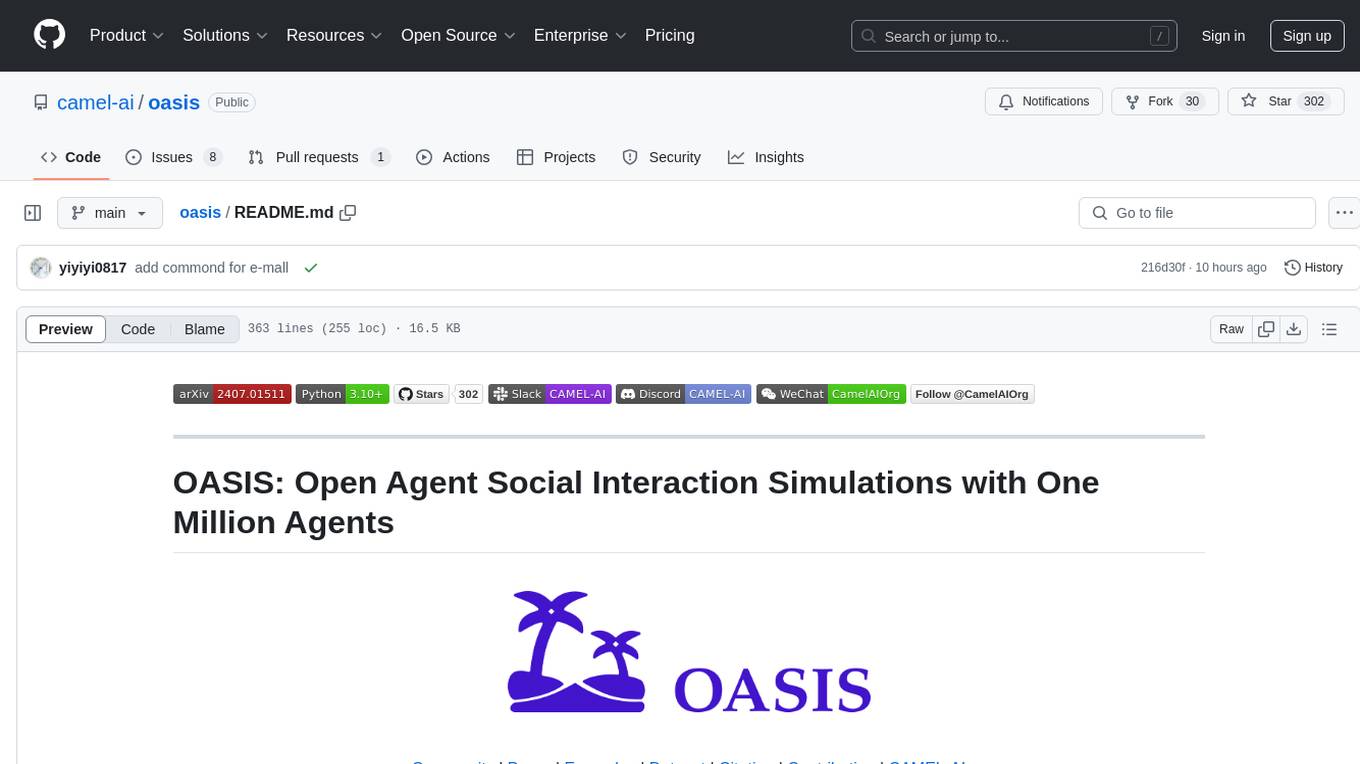
oasis
OASIS is a scalable, open-source social media simulator that integrates large language models with rule-based agents to realistically mimic the behavior of up to one million users on platforms like Twitter and Reddit. It facilitates the study of complex social phenomena such as information spread, group polarization, and herd behavior, offering a versatile tool for exploring diverse social dynamics and user interactions in digital environments. With features like scalability, dynamic environments, diverse action spaces, and integrated recommendation systems, OASIS provides a comprehensive platform for simulating social media interactions at a large scale.
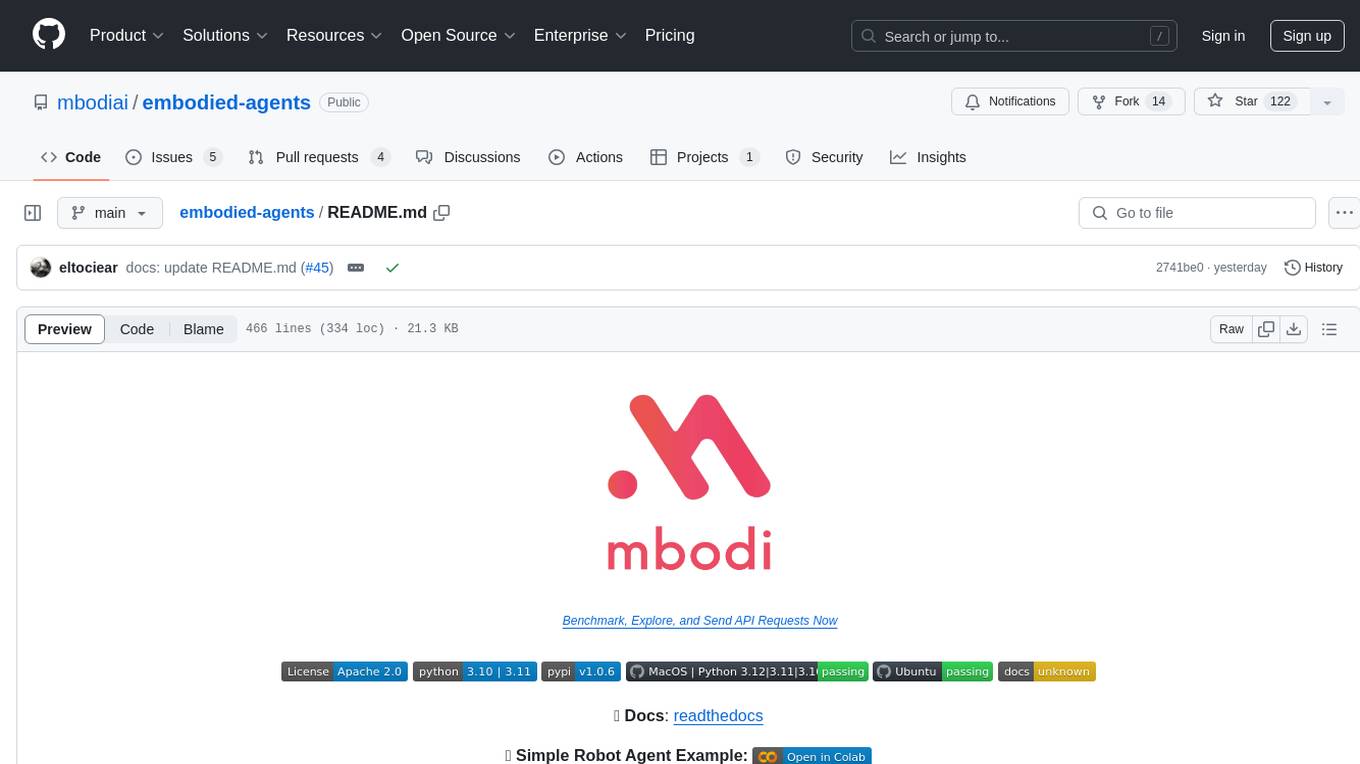
embodied-agents
Embodied Agents is a toolkit for integrating large multi-modal models into existing robot stacks with just a few lines of code. It provides consistency, reliability, scalability, and is configurable to any observation and action space. The toolkit is designed to reduce complexities involved in setting up inference endpoints, converting between different model formats, and collecting/storing datasets. It aims to facilitate data collection and sharing among roboticists by providing Python-first abstractions that are modular, extensible, and applicable to a wide range of tasks. The toolkit supports asynchronous and remote thread-safe agent execution for maximal responsiveness and scalability, and is compatible with various APIs like HuggingFace Spaces, Datasets, Gymnasium Spaces, Ollama, and OpenAI. It also offers automatic dataset recording and optional uploads to the HuggingFace hub.
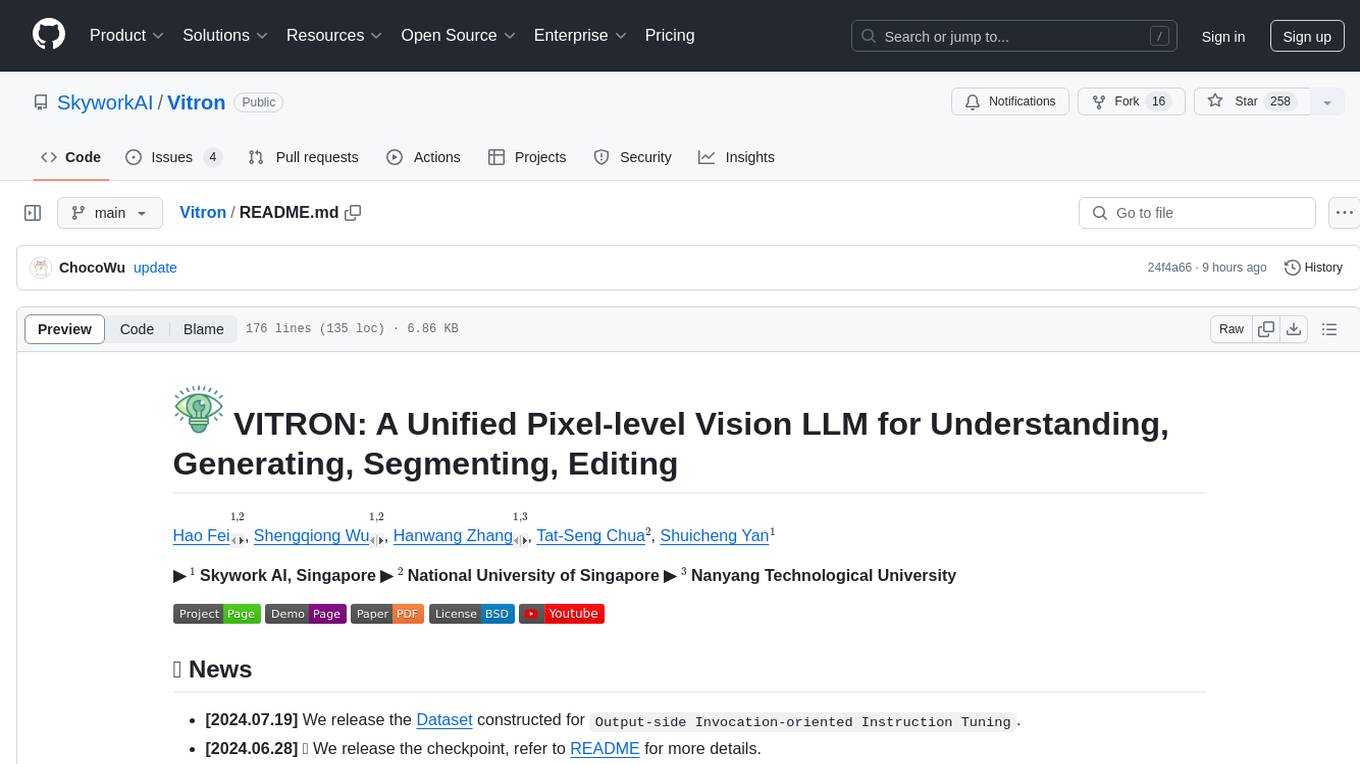
Vitron
Vitron is a unified pixel-level vision LLM designed for comprehensive understanding, generating, segmenting, and editing static images and dynamic videos. It addresses challenges in existing vision LLMs such as superficial instance-level understanding, lack of unified support for images and videos, and insufficient coverage across various vision tasks. The tool requires Python >= 3.8, Pytorch == 2.1.0, and CUDA Version >= 11.8 for installation. Users can deploy Gradio demo locally and fine-tune their models for specific tasks.
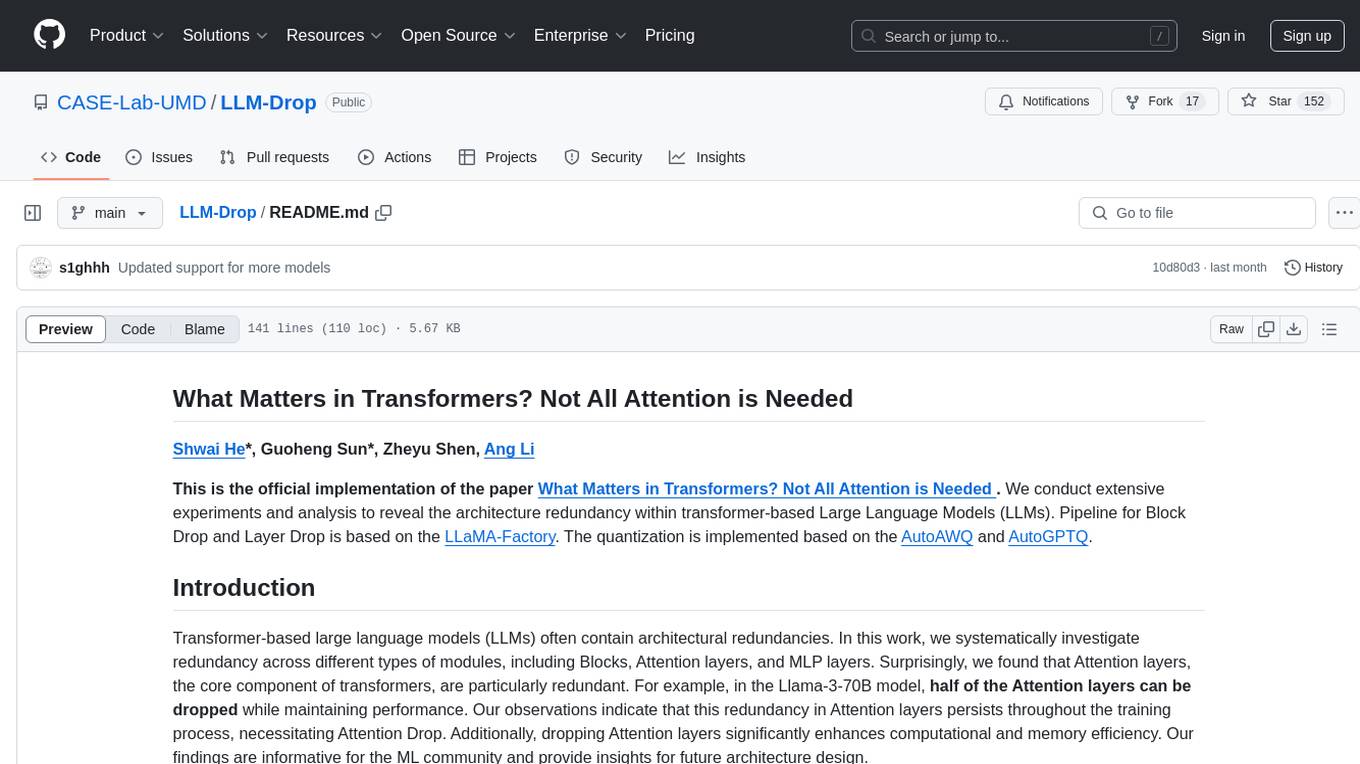
LLM-Drop
LLM-Drop is an official implementation of the paper 'What Matters in Transformers? Not All Attention is Needed'. The tool investigates redundancy in transformer-based Large Language Models (LLMs) by analyzing the architecture of Blocks, Attention layers, and MLP layers. It reveals that dropping certain Attention layers can enhance computational and memory efficiency without compromising performance. The tool provides a pipeline for Block Drop and Layer Drop based on LLaMA-Factory, and implements quantization using AutoAWQ and AutoGPTQ.
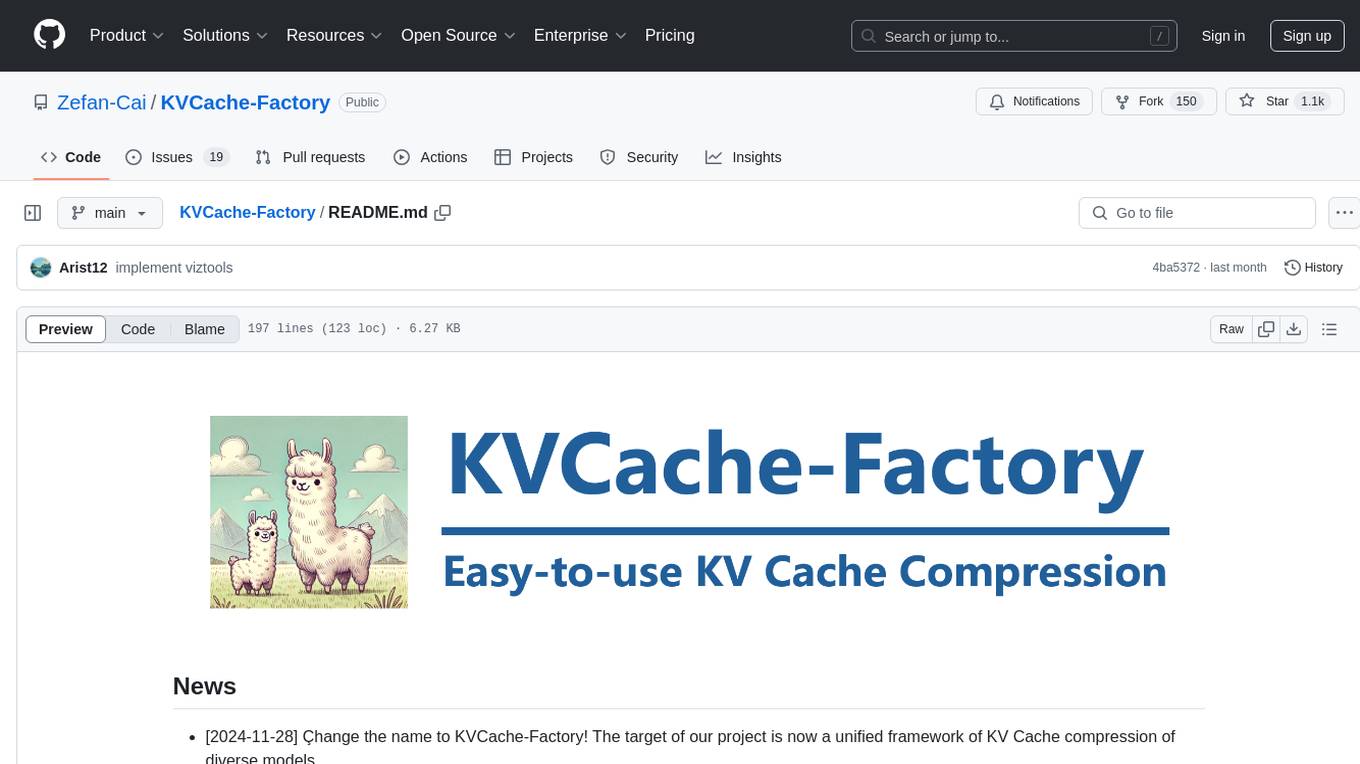
KVCache-Factory
KVCache-Factory is a unified framework for KV Cache compression of diverse models. It supports multi-GPUs inference with big LLMs and various attention implementations. The tool enables KV cache compression without Flash Attention v2, multi-GPU inference, and specific models like Mistral. It also provides functions for KV cache budget allocation and batch inference. The visualization tools help in understanding the attention patterns of models.
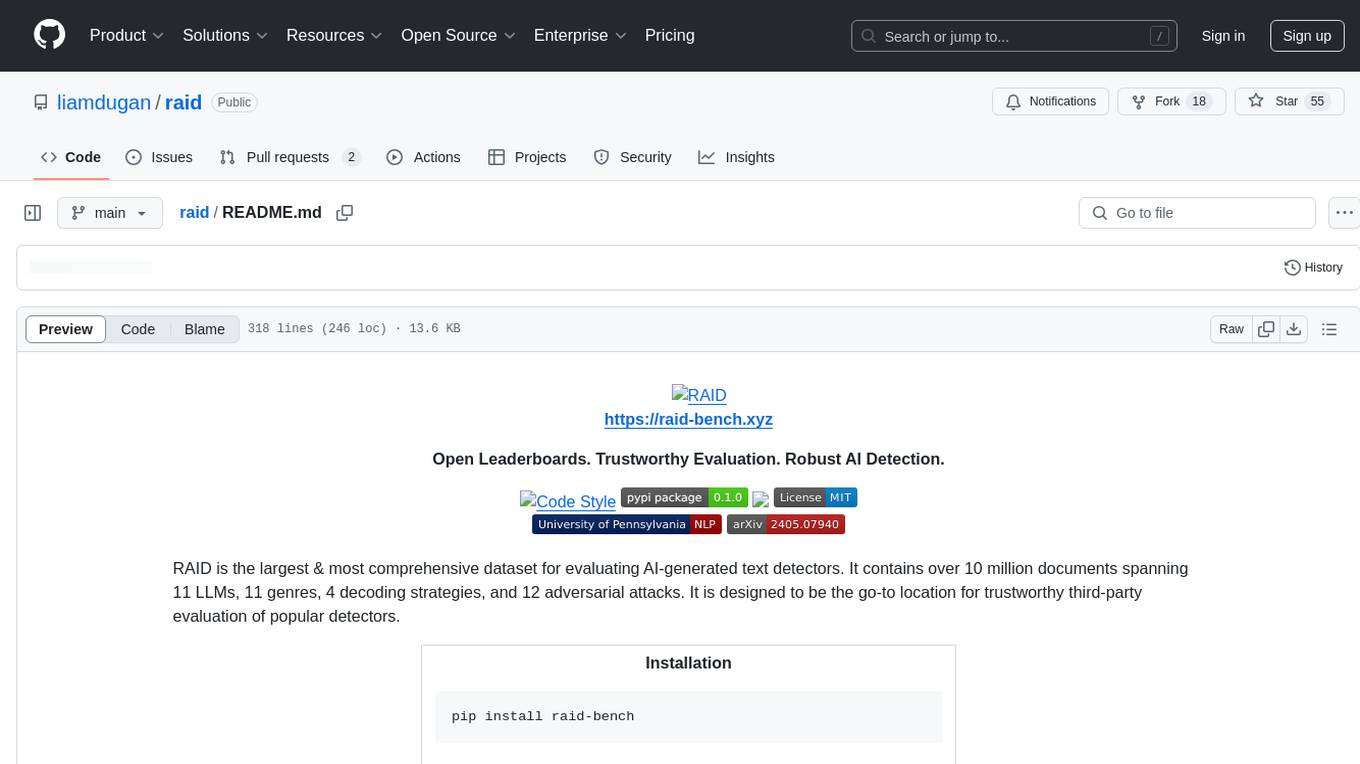
raid
RAID is the largest and most comprehensive dataset for evaluating AI-generated text detectors. It contains over 10 million documents spanning 11 LLMs, 11 genres, 4 decoding strategies, and 12 adversarial attacks. RAID is designed to be the go-to location for trustworthy third-party evaluation of popular detectors. The dataset covers diverse models, domains, sampling strategies, and attacks, making it a valuable resource for training detectors, evaluating generalization, protecting against adversaries, and comparing to state-of-the-art models from academia and industry.
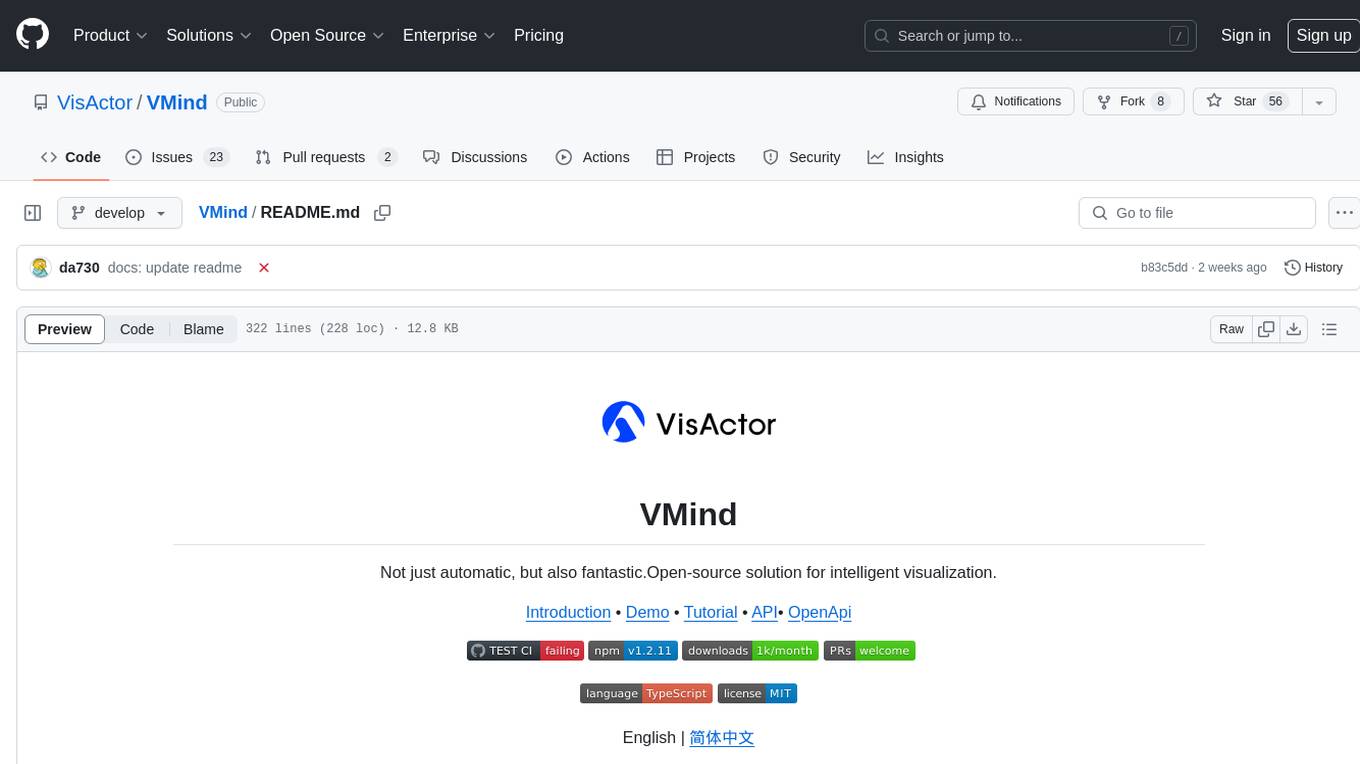
VMind
VMind is an open-source solution for intelligent visualization, providing an intelligent chart component based on LLM by VisActor. It allows users to create chart narrative works with natural language interaction, edit charts through dialogue, and export narratives as videos or GIFs. The tool is easy to use, scalable, supports various chart types, and offers one-click export functionality. Users can customize chart styles, specify themes, and aggregate data using LLM models. VMind aims to enhance efficiency in creating data visualization works through dialogue-based editing and natural language interaction.
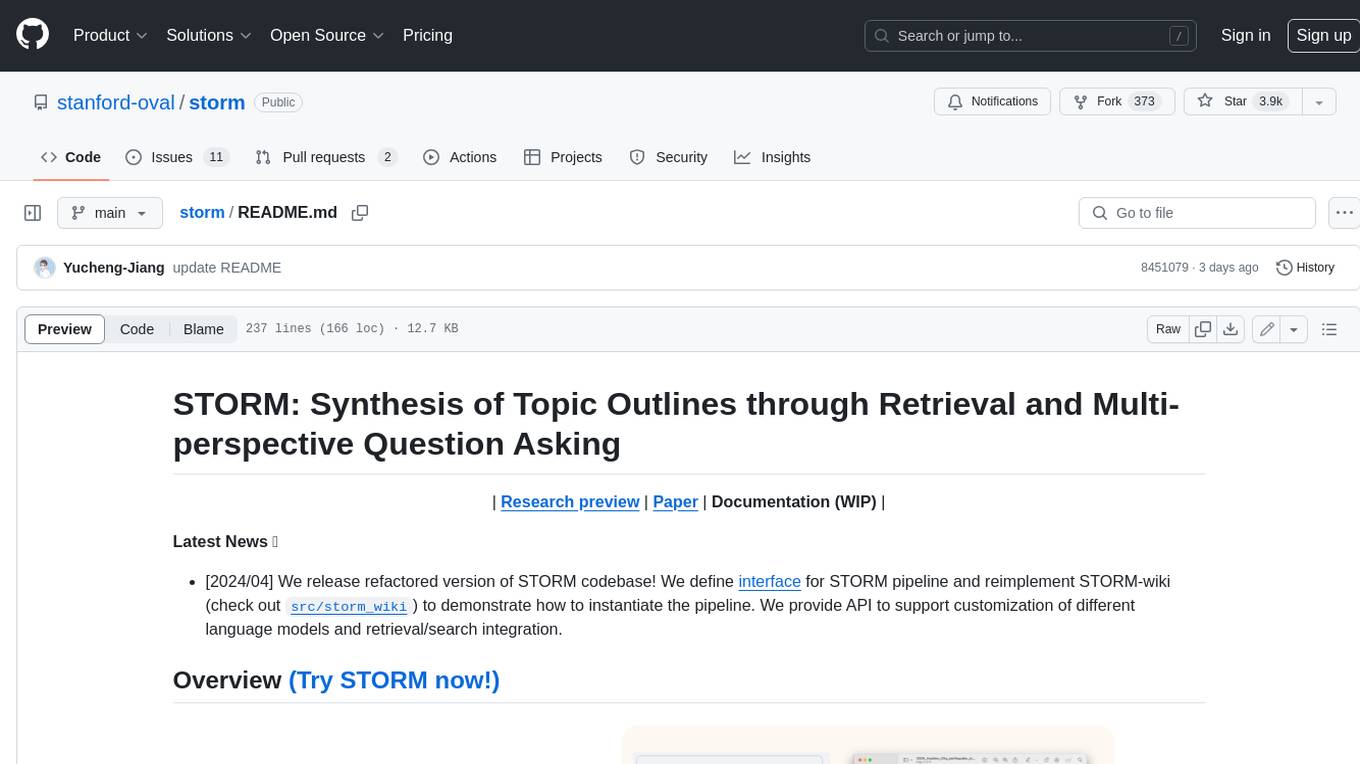
storm
STORM is a LLM system that writes Wikipedia-like articles from scratch based on Internet search. While the system cannot produce publication-ready articles that often require a significant number of edits, experienced Wikipedia editors have found it helpful in their pre-writing stage. **Try out our [live research preview](https://storm.genie.stanford.edu/) to see how STORM can help your knowledge exploration journey and please provide feedback to help us improve the system 🙏!**
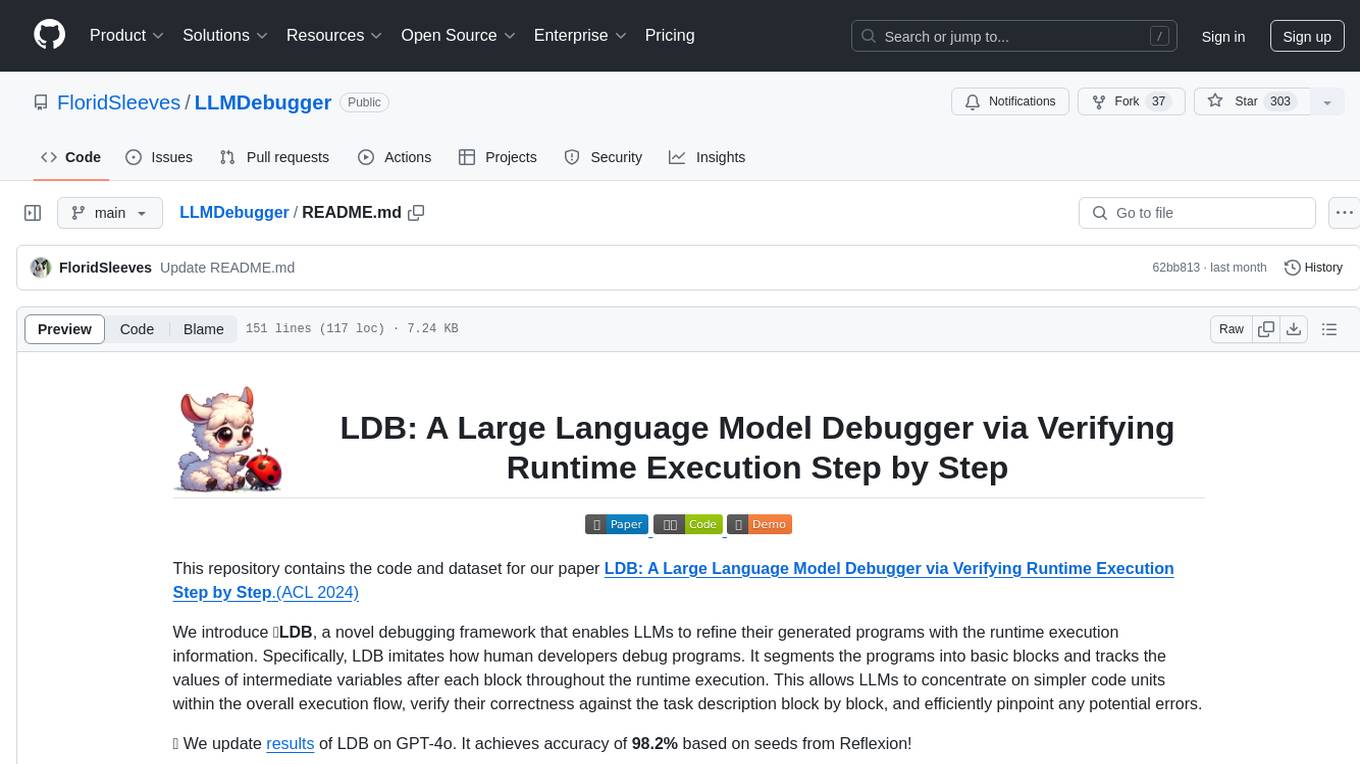
LLMDebugger
This repository contains the code and dataset for LDB, a novel debugging framework that enables Large Language Models (LLMs) to refine their generated programs by tracking the values of intermediate variables throughout the runtime execution. LDB segments programs into basic blocks, allowing LLMs to concentrate on simpler code units, verify correctness block by block, and pinpoint errors efficiently. The tool provides APIs for debugging and generating code with debugging messages, mimicking how human developers debug programs.

KaibanJS
KaibanJS is a JavaScript-native framework for building multi-agent AI systems. It enables users to create specialized AI agents with distinct roles and goals, manage tasks, and coordinate teams efficiently. The framework supports role-based agent design, tool integration, multiple LLMs support, robust state management, observability and monitoring features, and a real-time agentic Kanban board for visualizing AI workflows. KaibanJS aims to empower JavaScript developers with a user-friendly AI framework tailored for the JavaScript ecosystem, bridging the gap in the AI race for non-Python developers.
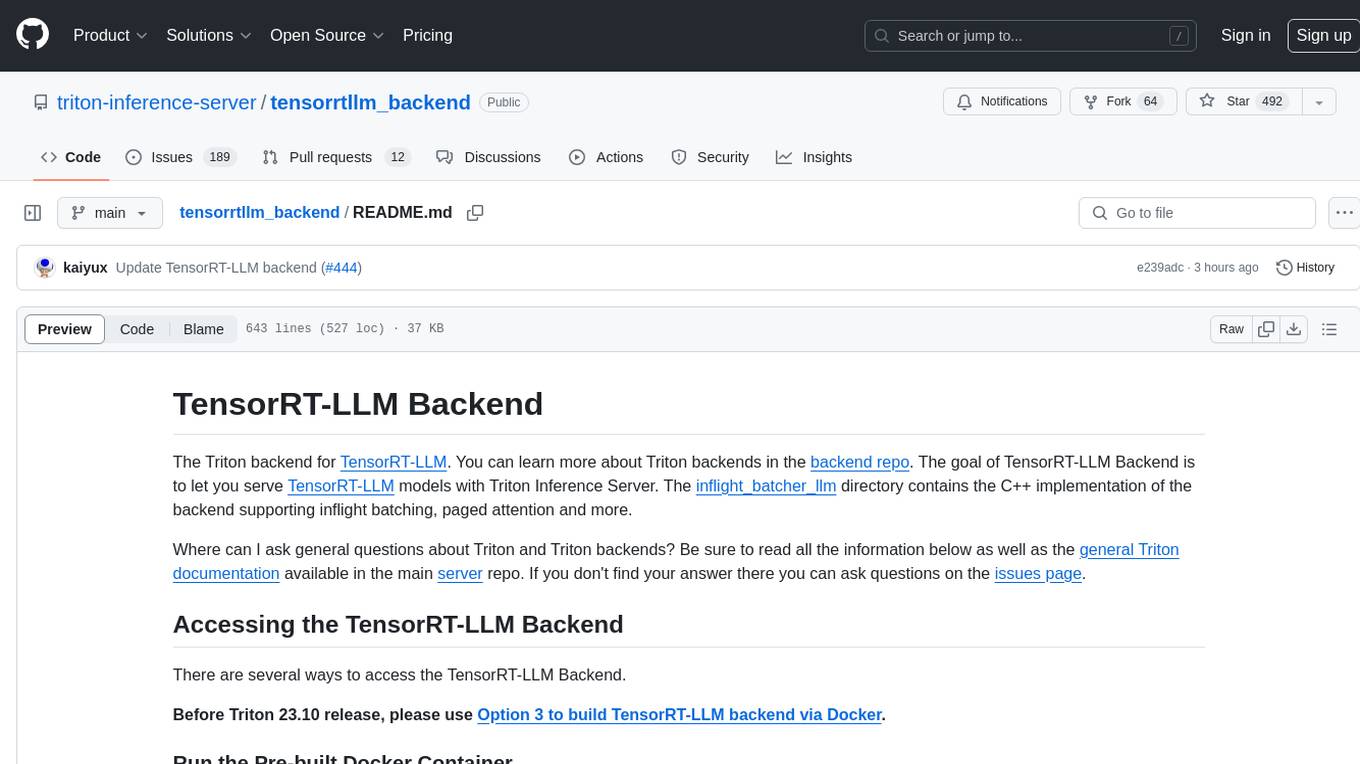
tensorrtllm_backend
The TensorRT-LLM Backend is a Triton backend designed to serve TensorRT-LLM models with Triton Inference Server. It supports features like inflight batching, paged attention, and more. Users can access the backend through pre-built Docker containers or build it using scripts provided in the repository. The backend can be used to create models for tasks like tokenizing, inferencing, de-tokenizing, ensemble modeling, and more. Users can interact with the backend using provided client scripts and query the server for metrics related to request handling, memory usage, KV cache blocks, and more. Testing for the backend can be done following the instructions in the 'ci/README.md' file.

topicGPT
TopicGPT is a repository containing scripts and prompts for the paper 'TopicGPT: Topic Modeling by Prompting Large Language Models' (NAACL'24). The 'topicgpt_python' package offers functions to generate high-level and specific topics, refine topics, assign topics to input text, and correct generated topics. It supports various APIs like OpenAI, VertexAI, Azure, Gemini, and vLLM for inference. Users can prepare data in JSONL format, run the pipeline using provided scripts, and evaluate topic alignment with ground-truth labels.
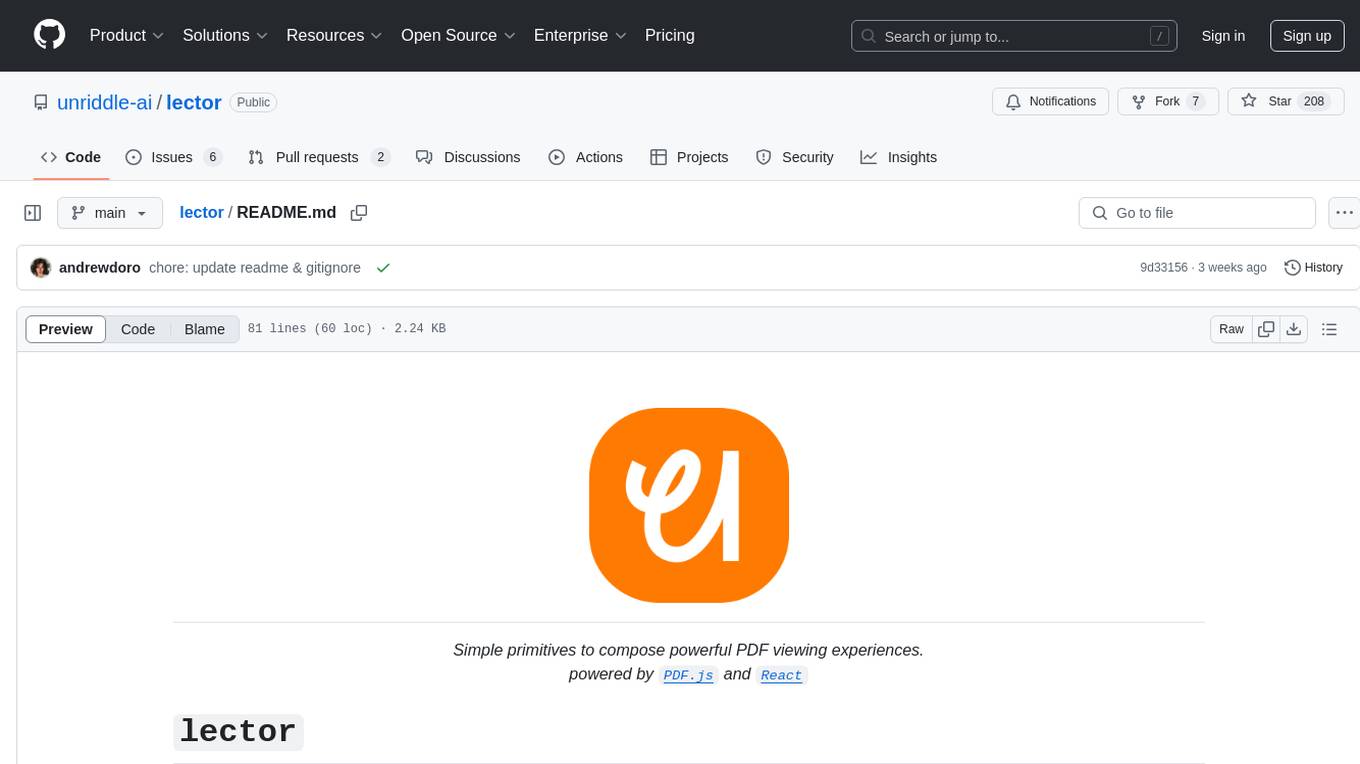
lector
Lector is a text analysis tool that helps users extract insights from unstructured text data. It provides functionalities such as sentiment analysis, keyword extraction, entity recognition, and text summarization. With Lector, users can easily analyze large volumes of text data to uncover patterns, trends, and valuable information. The tool is designed to be user-friendly and efficient, making it suitable for both beginners and experienced users in the field of natural language processing and text mining.
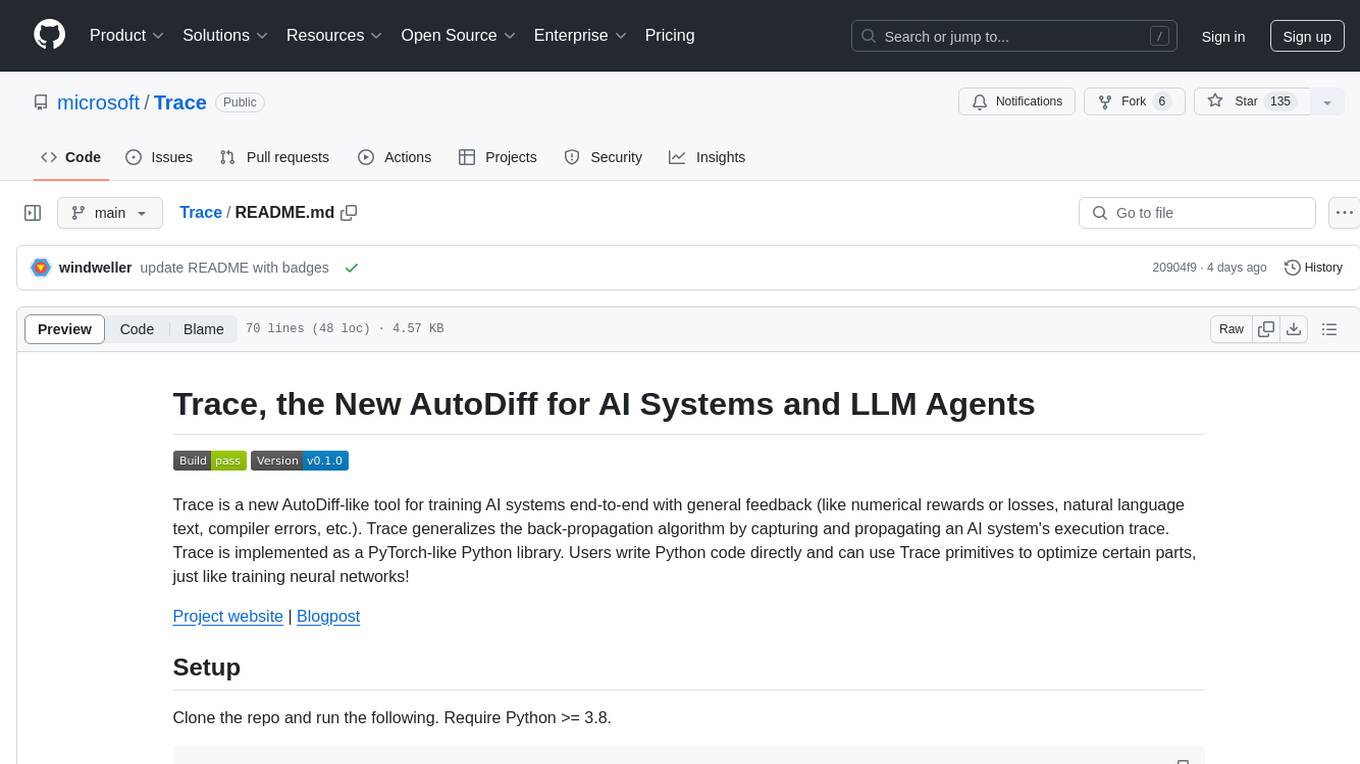
Trace
Trace is a new AutoDiff-like tool for training AI systems end-to-end with general feedback. It generalizes the back-propagation algorithm by capturing and propagating an AI system's execution trace. Implemented as a PyTorch-like Python library, users can write Python code directly and use Trace primitives to optimize certain parts, similar to training neural networks.
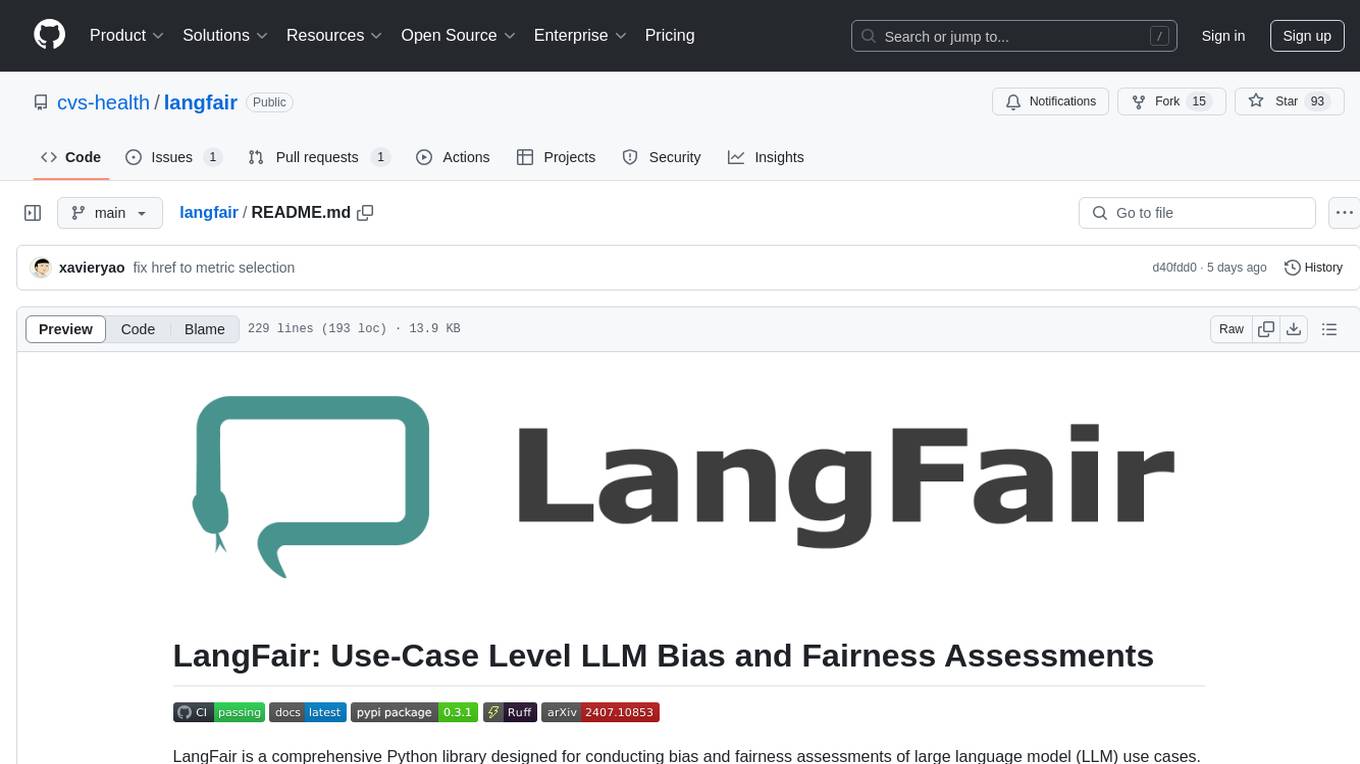
langfair
LangFair is a Python library for bias and fairness assessments of large language models (LLMs). It offers a comprehensive framework for choosing bias and fairness metrics, demo notebooks, and a technical playbook. Users can tailor evaluations to their use cases with a Bring Your Own Prompts approach. The focus is on output-based metrics practical for governance audits and real-world testing.
For similar tasks
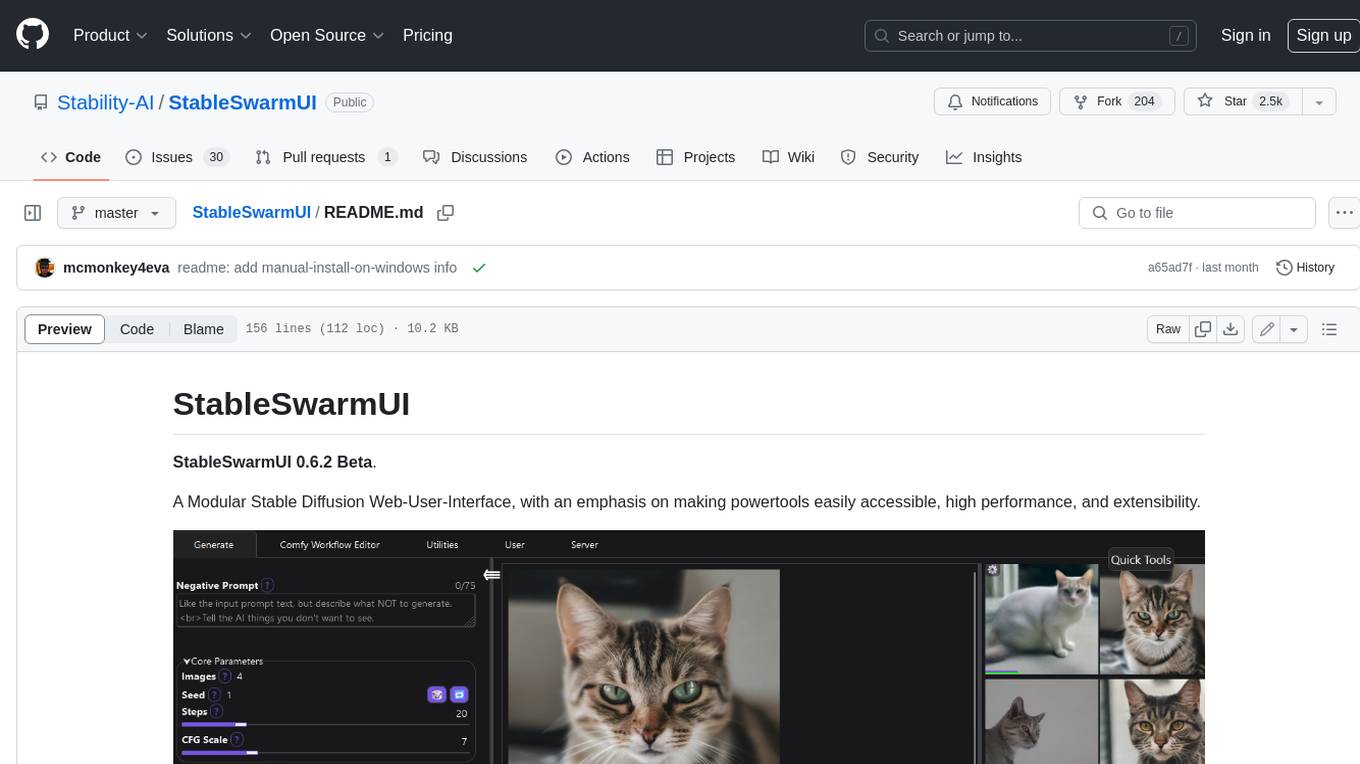
StableSwarmUI
StableSwarmUI is a modular Stable Diffusion web user interface that emphasizes making power tools easily accessible, high performance, and extensible. It is designed to be a one-stop-shop for all things Stable Diffusion, providing a wide range of features and capabilities to enhance the user experience.
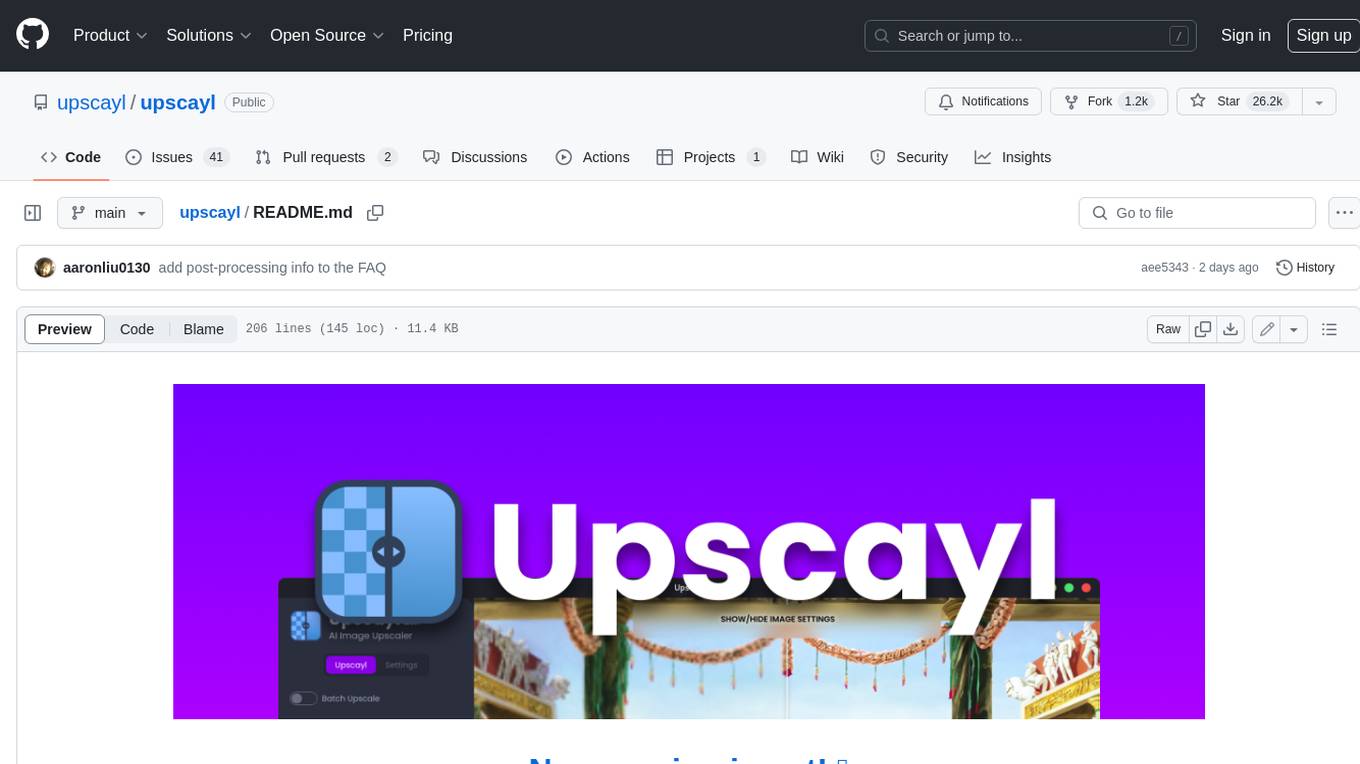
upscayl
Upscayl is a free and open-source AI image upscaler that uses advanced AI algorithms to enlarge and enhance low-resolution images without losing quality. It is a cross-platform application built with the Linux-first philosophy, available on all major desktop operating systems. Upscayl utilizes Real-ESRGAN and Vulkan architecture for image enhancement, and its backend is fully open-source under the AGPLv3 license. It is important to note that a Vulkan compatible GPU is required for Upscayl to function effectively.
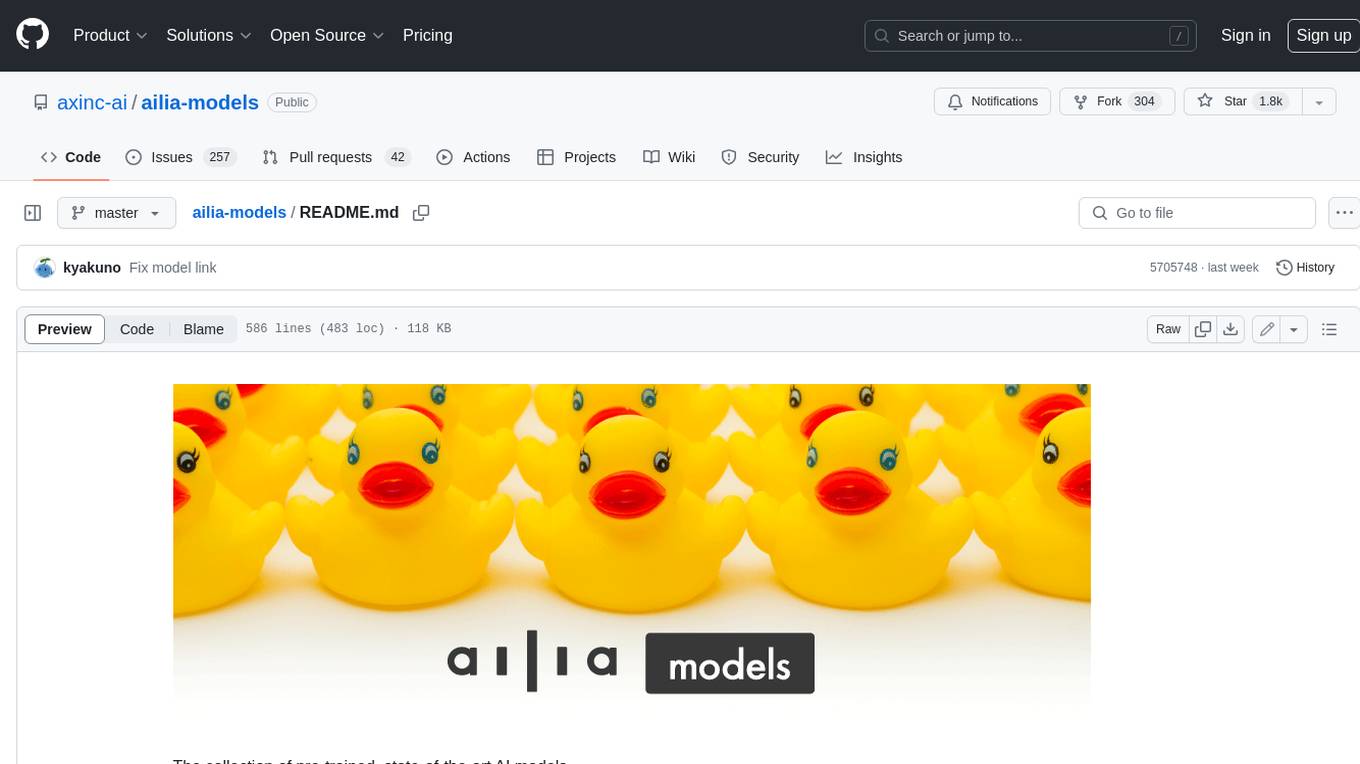
ailia-models
The collection of pre-trained, state-of-the-art AI models. ailia SDK is a self-contained, cross-platform, high-speed inference SDK for AI. The ailia SDK provides a consistent C++ API across Windows, Mac, Linux, iOS, Android, Jetson, and Raspberry Pi platforms. It also supports Unity (C#), Python, Rust, Flutter(Dart) and JNI for efficient AI implementation. The ailia SDK makes extensive use of the GPU through Vulkan and Metal to enable accelerated computing. # Supported models 323 models as of April 8th, 2024
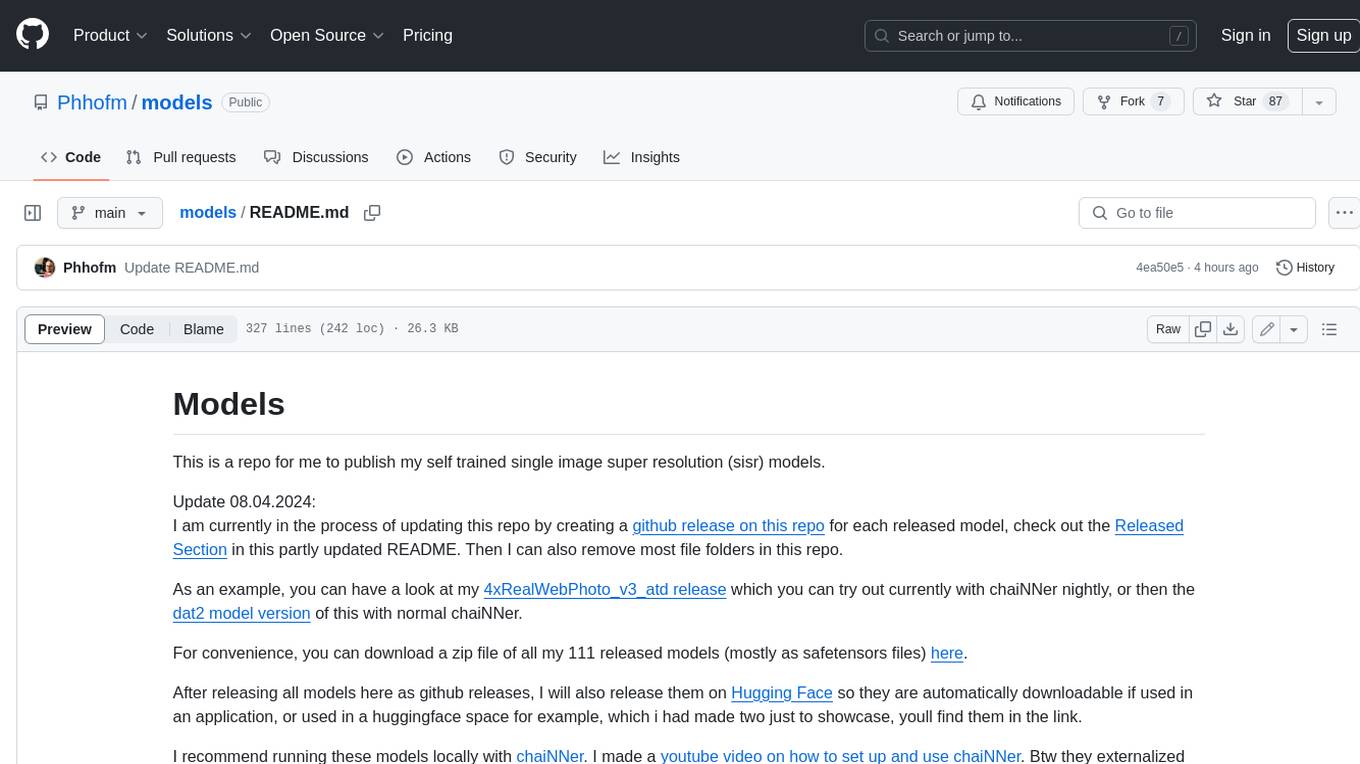
models
This repository contains self-trained single image super resolution (SISR) models. The models are trained on various datasets and use different network architectures. They can be used to upscale images by 2x, 4x, or 8x, and can handle various types of degradation, such as JPEG compression, noise, and blur. The models are provided as safetensors files, which can be loaded into a variety of deep learning frameworks, such as PyTorch and TensorFlow. The repository also includes a number of resources, such as examples, results, and a website where you can compare the outputs of different models.
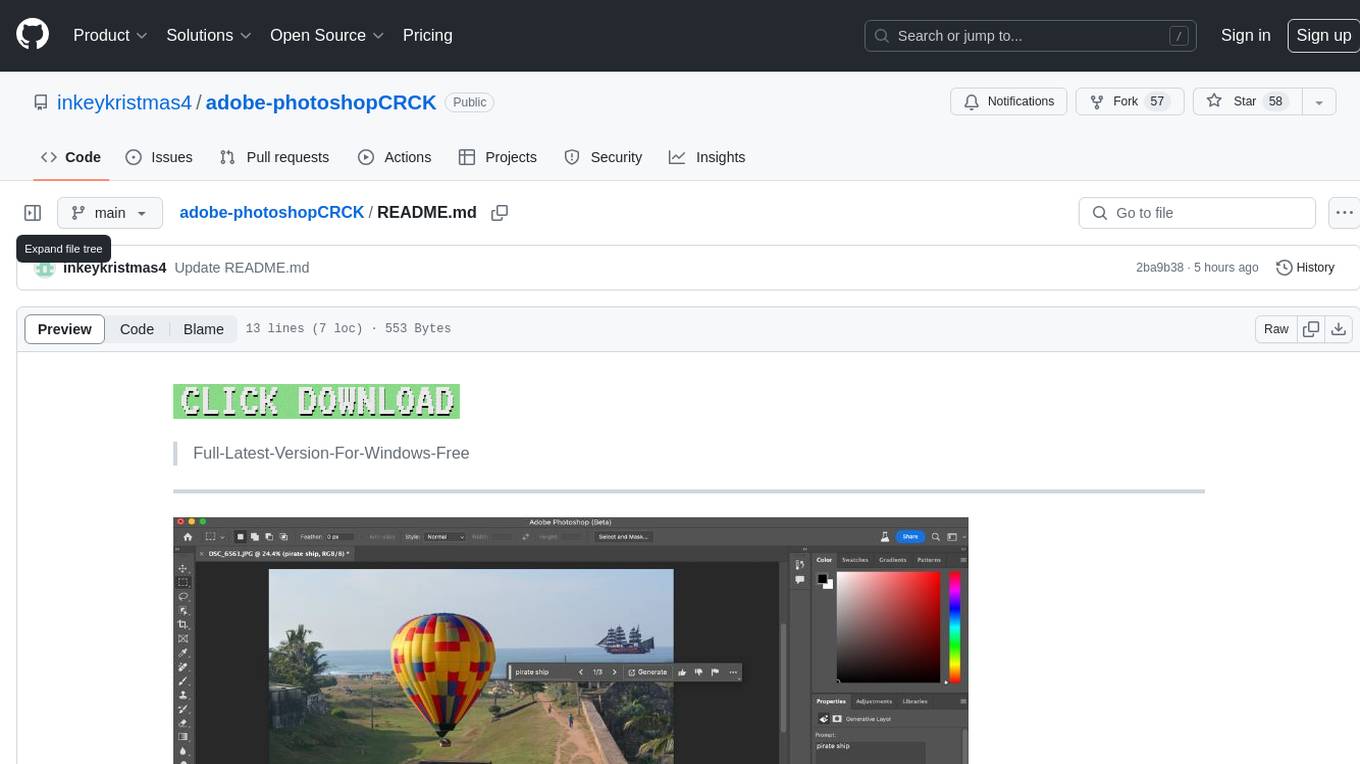
adobe-photoshopCRCK
Adobe PhotoshopCRCK is a tool designed to provide users with the latest version of Adobe Photoshop for free on Windows. It allows users to access advanced photo editing features and functionalities without the need for a paid subscription. The tool is intended for individuals looking to explore professional photo editing capabilities without incurring additional costs. With Adobe PhotoshopCRCK, users can enhance their images, create stunning graphics, and unleash their creativity through a wide range of editing tools and options.
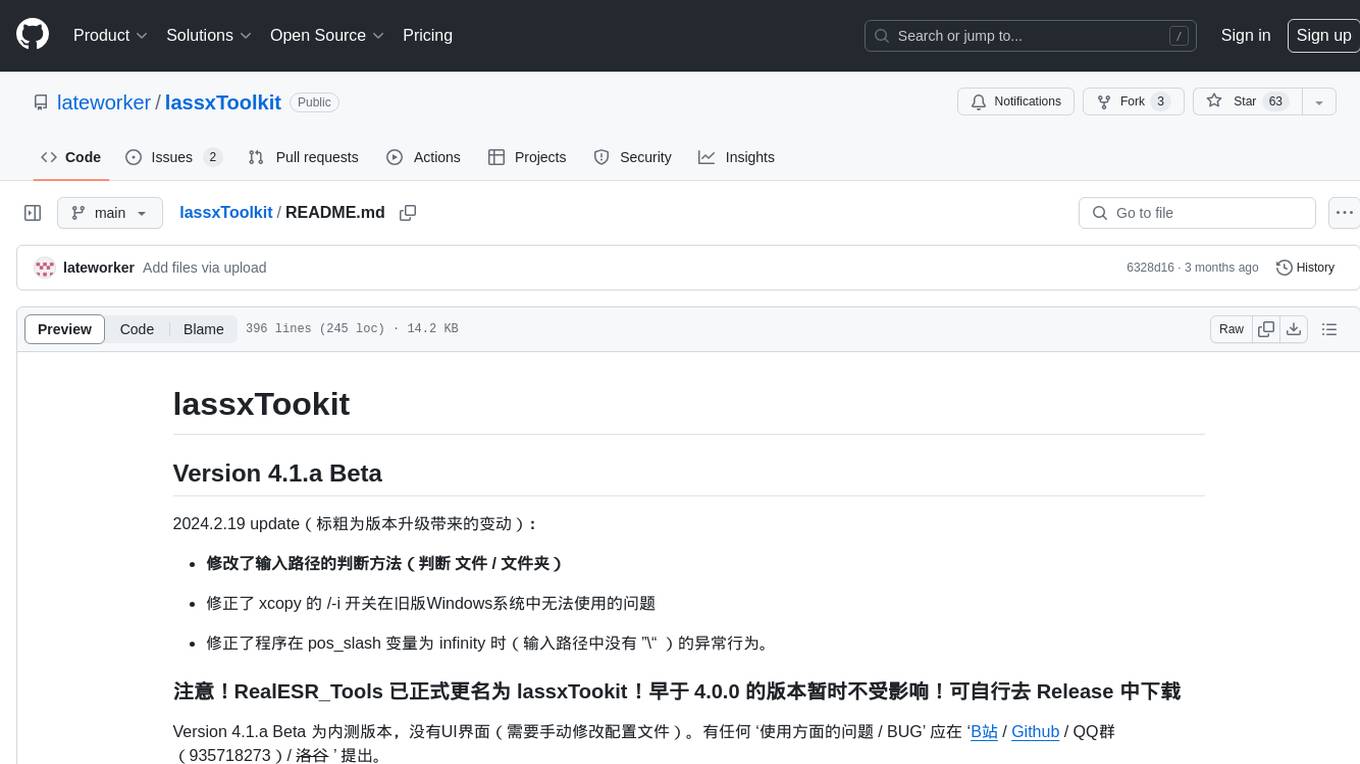
lassxToolkit
lassxToolkit is a versatile tool designed for file processing tasks. It allows users to manipulate files and folders based on specified configurations in a strict .json format. The tool supports various AI models for tasks such as image upscaling and denoising. Users can customize settings like input/output paths, error handling, file selection, and plugin integration. lassxToolkit provides detailed instructions on configuration options, default values, and model selection. It also offers features like tree restoration, recursive processing, and regex-based file filtering. The tool is suitable for users looking to automate file processing tasks with AI capabilities.
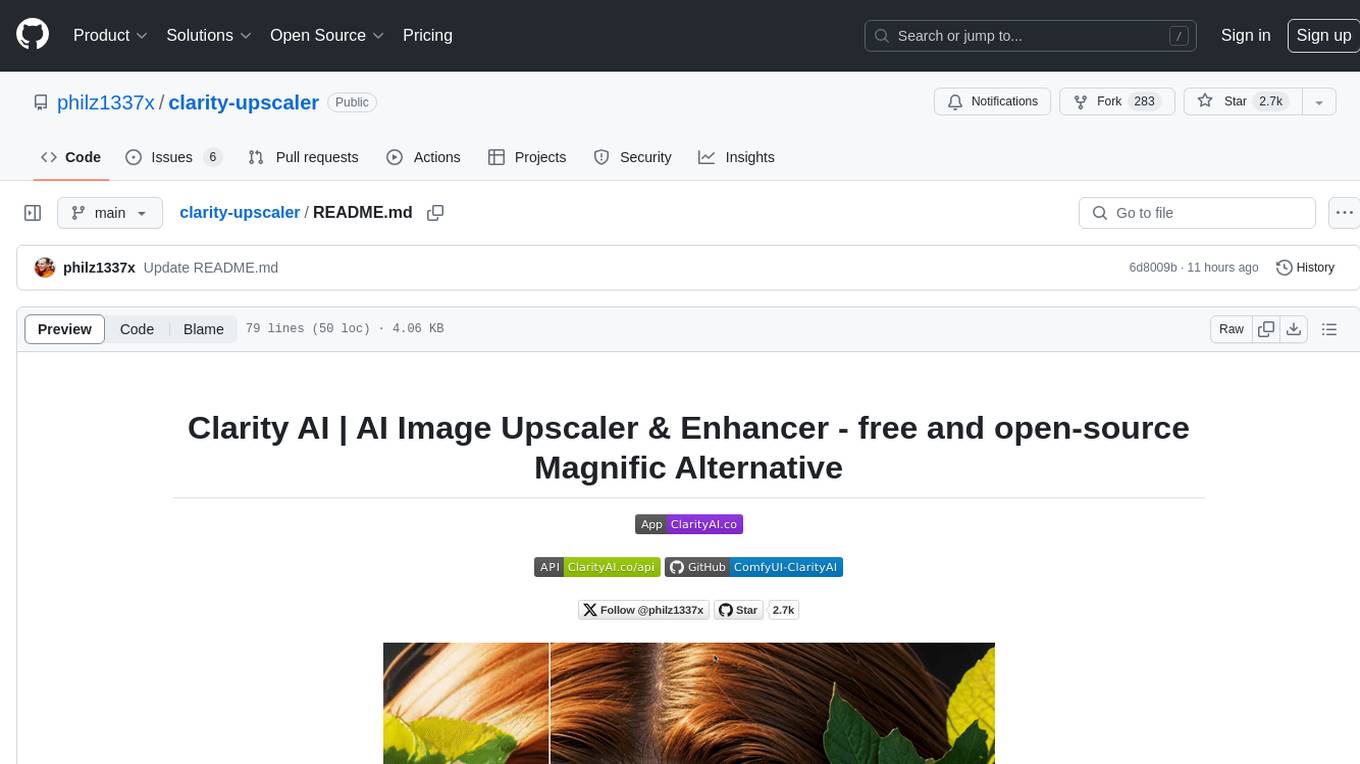
clarity-upscaler
Clarity AI is a free and open-source AI image upscaler and enhancer, providing an alternative to Magnific. It offers various features such as multi-step upscaling, resemblance fixing, speed improvements, support for custom safetensors checkpoints, anime upscaling, LoRa support, pre-downscaling, and fractality. Users can access the tool through the ClarityAI.co app, ComfyUI manager, API, or by deploying and running locally or in the cloud with cog or A1111 webUI. The tool aims to enhance image quality and resolution using advanced AI algorithms and models.
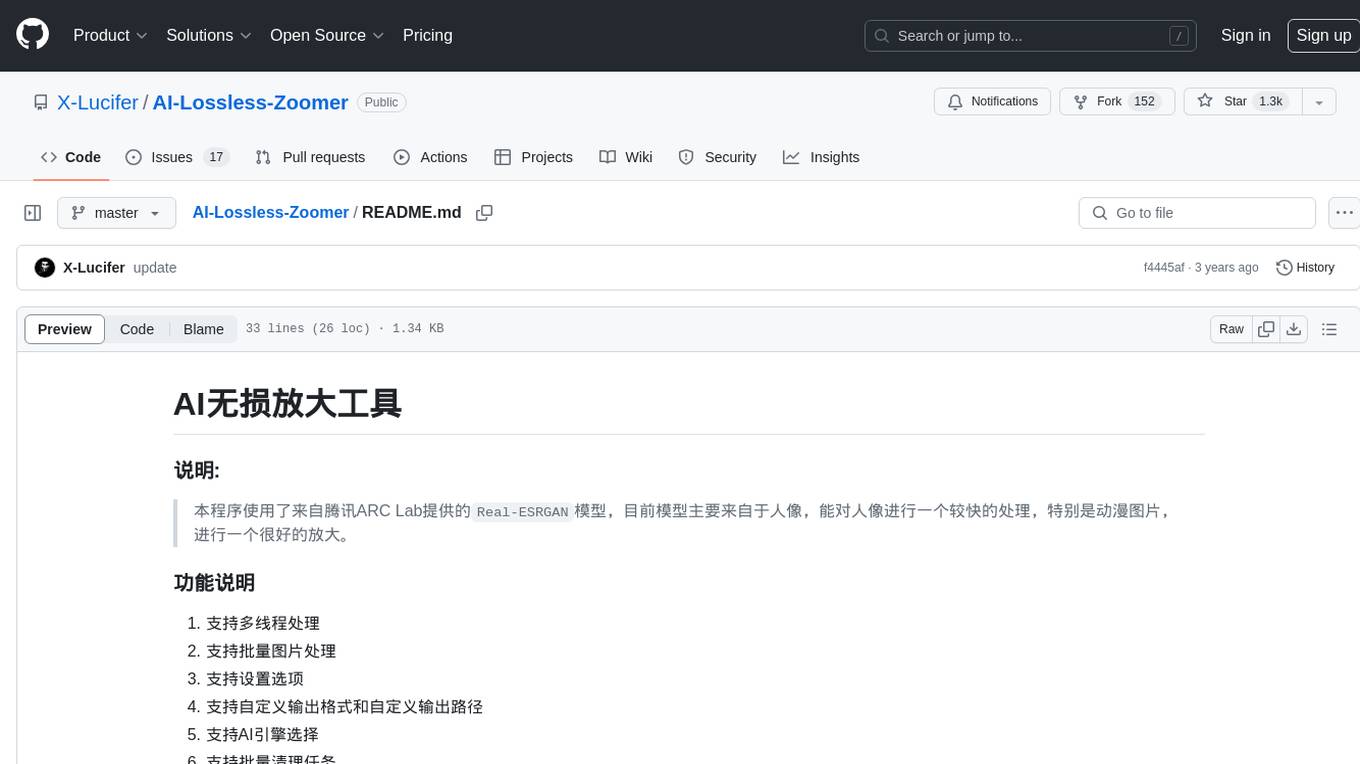
AI-Lossless-Zoomer
AI-Lossless-Zoomer is a tool that utilizes the Real-ESRGAN model provided by Tencent ARC Lab to enhance images, particularly portraits and anime pictures, with fast processing. It supports multi-thread processing, batch image processing, customizable options, output formats, output paths, AI engine selection, and batch cleaning tasks. The tool is designed for Windows 7 or later with .NET Framework 4.6+. Users can choose between the installable version (.exe) and the portable version (.zip) that includes the latest AI engine. The tool is efficient for enlarging images while maintaining quality.
For similar jobs

weave
Weave is a toolkit for developing Generative AI applications, built by Weights & Biases. With Weave, you can log and debug language model inputs, outputs, and traces; build rigorous, apples-to-apples evaluations for language model use cases; and organize all the information generated across the LLM workflow, from experimentation to evaluations to production. Weave aims to bring rigor, best-practices, and composability to the inherently experimental process of developing Generative AI software, without introducing cognitive overhead.

LLMStack
LLMStack is a no-code platform for building generative AI agents, workflows, and chatbots. It allows users to connect their own data, internal tools, and GPT-powered models without any coding experience. LLMStack can be deployed to the cloud or on-premise and can be accessed via HTTP API or triggered from Slack or Discord.

VisionCraft
The VisionCraft API is a free API for using over 100 different AI models. From images to sound.

kaito
Kaito is an operator that automates the AI/ML inference model deployment in a Kubernetes cluster. It manages large model files using container images, avoids tuning deployment parameters to fit GPU hardware by providing preset configurations, auto-provisions GPU nodes based on model requirements, and hosts large model images in the public Microsoft Container Registry (MCR) if the license allows. Using Kaito, the workflow of onboarding large AI inference models in Kubernetes is largely simplified.

PyRIT
PyRIT is an open access automation framework designed to empower security professionals and ML engineers to red team foundation models and their applications. It automates AI Red Teaming tasks to allow operators to focus on more complicated and time-consuming tasks and can also identify security harms such as misuse (e.g., malware generation, jailbreaking), and privacy harms (e.g., identity theft). The goal is to allow researchers to have a baseline of how well their model and entire inference pipeline is doing against different harm categories and to be able to compare that baseline to future iterations of their model. This allows them to have empirical data on how well their model is doing today, and detect any degradation of performance based on future improvements.

tabby
Tabby is a self-hosted AI coding assistant, offering an open-source and on-premises alternative to GitHub Copilot. It boasts several key features: * Self-contained, with no need for a DBMS or cloud service. * OpenAPI interface, easy to integrate with existing infrastructure (e.g Cloud IDE). * Supports consumer-grade GPUs.

spear
SPEAR (Simulator for Photorealistic Embodied AI Research) is a powerful tool for training embodied agents. It features 300 unique virtual indoor environments with 2,566 unique rooms and 17,234 unique objects that can be manipulated individually. Each environment is designed by a professional artist and features detailed geometry, photorealistic materials, and a unique floor plan and object layout. SPEAR is implemented as Unreal Engine assets and provides an OpenAI Gym interface for interacting with the environments via Python.

Magick
Magick is a groundbreaking visual AIDE (Artificial Intelligence Development Environment) for no-code data pipelines and multimodal agents. Magick can connect to other services and comes with nodes and templates well-suited for intelligent agents, chatbots, complex reasoning systems and realistic characters.


